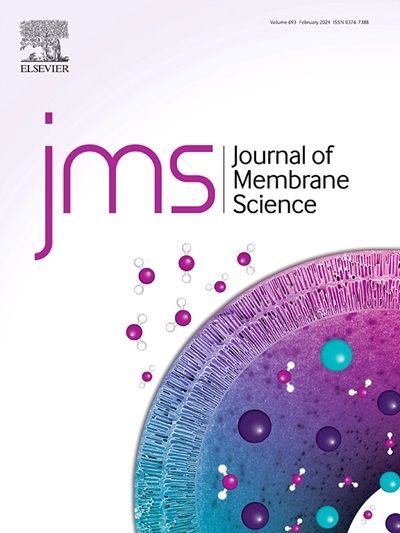Electrically conductive laser-induced graphene engraved Janus membrane for membrane distillation
IF 8.4
1区 工程技术
Q1 ENGINEERING, CHEMICAL
引用次数: 0
Abstract
Electrically conductive membranes (ECMs) show significant potential in overcoming wetting and pore-blocking challenges in membrane distillation (MD) processes. In this study, a novel Janus ECM has been developed by laser-induced graphene (LIG) engraving technique on a polyamide-imide (PAI) membrane, complemented by a silica-infused PVDF layer on the opposite side to create a unique 'sandwich' structure. The Janus structure integrates the hydrophilicity of the LIG layer with the hydrophobicity of the PVDF layer, facilitating efficient vapor flux. The optimized membrane achieved electrical conductivity of 142 ± 1.5 S/cm, water vapor flux of 11.3 ± 0.56 LMH, and 99.77 ± 0.1 % salt rejection. Its underwater oleophobicity effectively resisted wetting by surfactants and oil-water emulsions. Furthermore, applying a cathodic potential of 3V enhanced the electrostatic interactions between organic foulants and the membrane surface, reducing fouling and achieving a minimal flux decline of 2.45 %/hr over 6 h. Experiments on mineral scaling mitigation revealed that AC electric fields outperformed DC fields. A square waveform at 5Hz frequency achieved over 99 % salt rejection with minimal flux decline for monovalent and multivalent ion solutions, attributed to enhanced electrophoretic mixing under the AC field. A long-term test with the monovalent salt solution under AC/1V/5Hz(square waveform) exhibited excellent flux with a minimum flux decline of 1.35 %/hr after 18 h of experiment with no significant change in the membrane LIG structure. The in-situ LIG engraving process and the membrane's adaptability to varying electric field applications highlight its potential for large-scale use.

用于膜蒸馏的导电激光诱导石墨烯雕刻 Janus 膜
本文章由计算机程序翻译,如有差异,请以英文原文为准。
求助全文
约1分钟内获得全文
求助全文
来源期刊

Journal of Membrane Science
工程技术-高分子科学
CiteScore
17.10
自引率
17.90%
发文量
1031
审稿时长
2.5 months
期刊介绍:
The Journal of Membrane Science is a publication that focuses on membrane systems and is aimed at academic and industrial chemists, chemical engineers, materials scientists, and membranologists. It publishes original research and reviews on various aspects of membrane transport, membrane formation/structure, fouling, module/process design, and processes/applications. The journal primarily focuses on the structure, function, and performance of non-biological membranes but also includes papers that relate to biological membranes. The Journal of Membrane Science publishes Full Text Papers, State-of-the-Art Reviews, Letters to the Editor, and Perspectives.
 求助内容:
求助内容: 应助结果提醒方式:
应助结果提醒方式:


